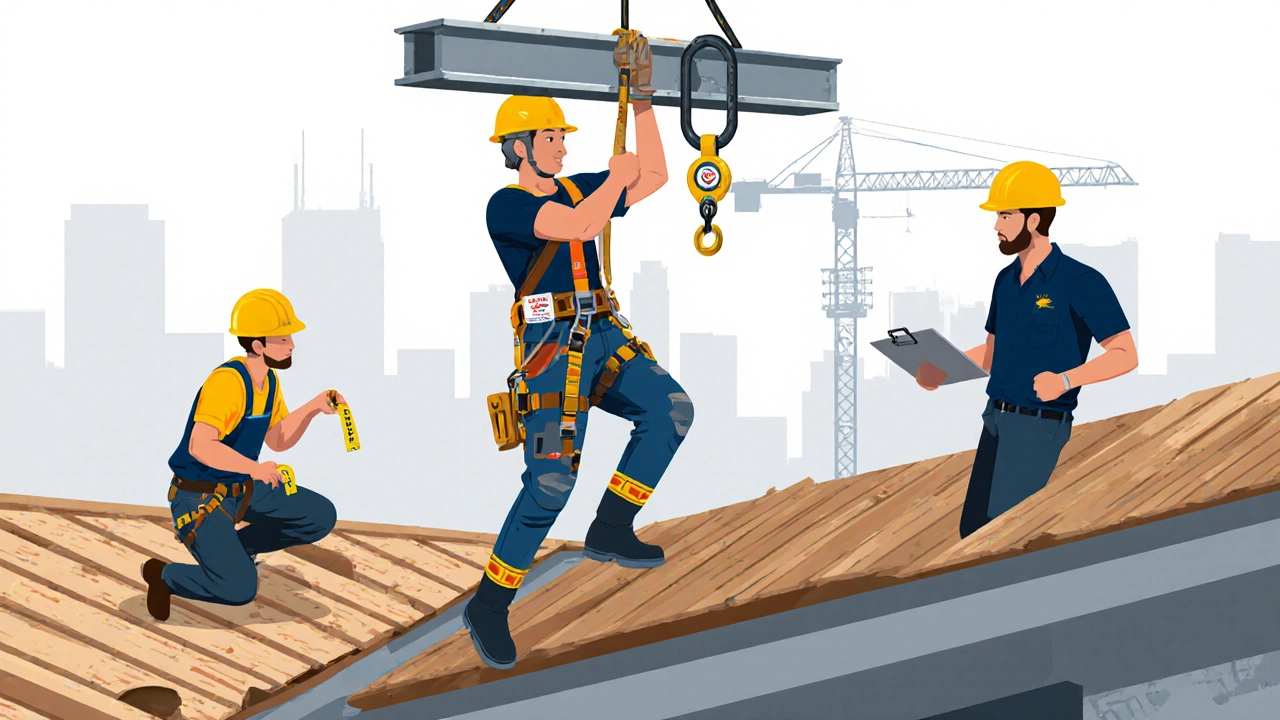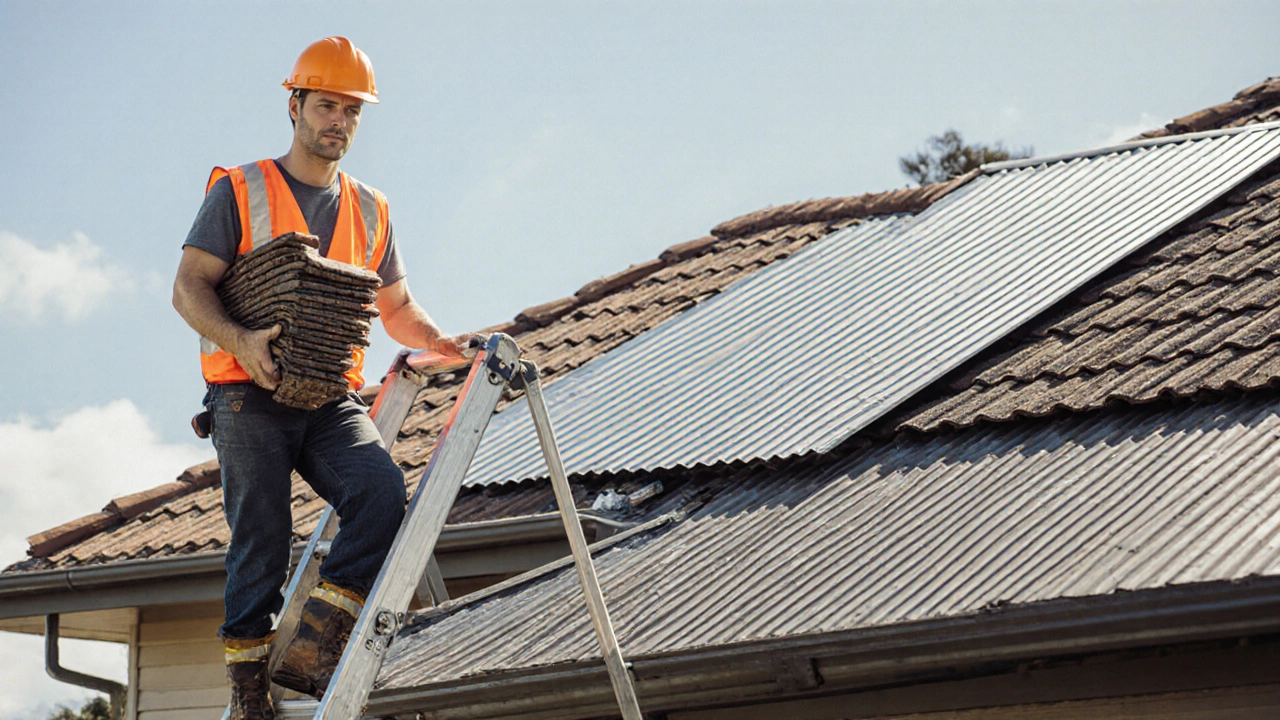Roofing Job Title Finder
Find Your Roofing Professional
Select your project details to identify the appropriate roofing job title and requirements.
Recommended Job Title
What to check when hiring:
- License verification (RBP registration)
- Proof of insurance (public liability)
- References from similar projects
When you look up a house repair quote, the person on the ladder is often just called a roof worker - a broad label that covers many specialised roles. Knowing the exact title matters whether you’re hiring help, planning a career, or comparing wages. Below we break down the most common names, what each does, and how they fit into New Zealand’s building rules.
Why the exact title matters
Different titles signal varying levels of responsibility, training, and legal liability. A homeowner who hires a "roofer" might get a skilled installer, while a "roofing contractor" can sign off on permits and insurance. Understanding these nuances prevents miscommunication, costly re‑works, and safety breaches.
Core definition: Roof worker
Roof worker is a construction professional who installs, repairs, maintains, or inspects roofing systems on residential, commercial, or industrial structures. The role can be full‑time, subcontracted, or part of a larger roofing crew. In New Zealand, roof workers must follow the Building Code and the Occupational Health and Safety (OHS) regulations.
Common roofing job titles
Below is a quick rundown of the titles you’ll see on quotes, job ads, and safety certificates.
- Roofer - General term for anyone who works on roofs, often skilled in shingle or tile installation.
- Roofing contractor - Business owner or licensed entity that can obtain permits, provide insurance, and oversee larger projects.
- Roof installer - Specialist who focuses on the physical placement of roofing materials, usually under a contractor’s direction.
- Roof rigger - Expert in handling heavy or steep‑slope roofs, often using winches, cranes, or safety harnesses.
- Roof decker - Worker who installs or repairs the decking (the wood or metal base) that supports the final roofing material.
- Roofing supervisor - Oversees crews, ensures compliance with the Building Code, and manages on‑site safety.
Comparison of titles, duties, and typical earnings (NZ)
| Title | Primary Duties | Typical Annual Salary (NZ$) |
|---|---|---|
| Roofer | Install, repair, and replace shingles, tiles, or metal panels; basic safety checks. | 45,000 - 60,000 |
| Roofing contractor | Obtain permits, manage budgets, coordinate sub‑trades, provide insurance. | 70,000 - 110,000 |
| Roof installer | Specialise in laying roofing sheets, flashing, and waterproof membranes. | 48,000 - 65,000 |
| Roof rigger | Operate lifting gear, secure workers on steep pitches, enforce OHS protocols. | 55,000 - 80,000 |
| Roof decker | Fit or replace roof decking, assess structural integrity, prepare surface. | 50,000 - 70,000 |
| Roofing supervisor | Lead crews, schedule work, conduct final inspections, liaise with clients. | 65,000 - 90,000 |

Qualifications and training pathways
Most roof workers start with a Level 2 or Level 3 Construction Trade Certificate from a recognised polytechnic (e.g., Unitec or Tai Tokerau). From there, apprenticeships (“New Zealand Apprenticeship Programme”) provide on‑the‑job learning for 3‑4 years.
Specific titles may require extra credentials:
- Roofing contractor - Must hold a Contractor Registration under the Registered Building Practitioners (RBP) scheme and carry a public liability insurance of at least $20 million.
- Roof rigger - Needs a high‑risk work licence for scaffolding or rope access (NZ HRC Safety Certification).
- Roof decker - Often comes from a carpentry background with a Level 4 Carpentry & Joinery qualification.
Legal and safety framework in New Zealand
The New Zealand Building Code (Clause B1 for structures, B2 for moisture protection) dictates material performance and installation methods. All roof workers must also follow the Health and Safety at Work Act 2015. Failure to comply can result in fines, work stoppages, or insurance disputes.
Key compliance steps:
- Confirm the worker holds a valid RBP or relevant high‑risk licence.
- Check that the company’s insurance covers both public liability and workers’ compensation.
- Ask for a written method statement that outlines fall‑protection measures.
- Ensure a pre‑start meeting reviews the building consent and any special conditions.
How to hire the right roof professional
Start by matching the job scope to the appropriate title. If you need a simple shingle replacement, a qualified roofer will suffice. For a full roof replacement on a multi‑storey commercial building, look for a licensed roofing contractor with an experienced roofing supervisor.
Use this checklist when requesting quotes:
- Confirm the exact title and licence number (e.g., RBP‑12345).
- Ask for proof of insurance and workers’ compensation coverage.
- Request references from recent projects similar in size and roof type.
- Check that the team includes any specialised roles needed (rigger, decker).
- Get a written timeline and payment schedule that aligns with milestones.

Career outlook for roof workers in Auckland and beyond
Demand for skilled roof workers is projected to rise 8 % annually through 2030, driven by the push for better insulation, solar‑panel integration, and replacement of aging roofing stock. Auckland’s construction boom means higher wages and more apprenticeship spots, especially for those willing to specialise in green roofing systems (e.g., standing‑seam metal, cool‑roof coatings).
Quick reference checklist
| Project Size | Best Title to Hire | Key Qualification |
|---|---|---|
| Small residential repair | Roofer | Level 2 Trade Certificate |
| Full roof replacement (home) | Roof installer + Roofer | Apprenticeship + OHS licence |
| Multi‑storey commercial | Roofing contractor + Supervisor | RBP registration, insurance |
| Steep‑slope, heavy material | Roof rigger | High‑risk work licence |
| Deck replacement | Roof decker | Level 4 Carpentry qualification |
Frequently Asked Questions
What’s the difference between a roofer and a roofing contractor?
A roofer is the tradesperson who physically installs or repairs roofing material. A roofing contractor is the business entity (or licensed individual) that can obtain permits, provide insurance, and manage the overall project. Contractors can hire multiple roofers and are legally responsible for compliance.
Do I need a licence to hire a roofer in Auckland?
While the individual roofer does not need a separate licence, the company they work for must hold a valid Registered Building Practitioner (RBP) registration for roofing. Always ask to see the registration number before signing a contract.
What safety equipment should a roof rigger use?
Key gear includes a full‑body harness, fall‑arrest lanyard, anchor points complying with NZS 4504, and, for heavy lifts, a certified winch or crane. A high‑risk work licence is mandatory for operating this equipment.
How long does a typical roof replacement take?
For a standard 2‑storey residential roof, expect 5‑7 working days once the decking is ready. Complex roofs with steep pitches, multiple layers, or custom flashings can extend to 10‑14 days.
Are there green‑roofing qualifications?
Yes. Many institutes now offer a Level 5 Certificate in Sustainable Roofing, covering solar‑panel integration, cool‑roof coatings, and vegetative roof systems. Holding this qualification can increase earning potential by up to 15 %.

Written by Fletcher Abernathy
View all posts by: Fletcher Abernathy